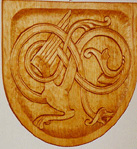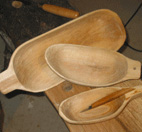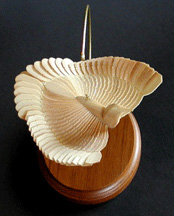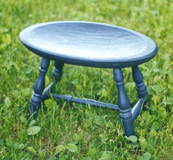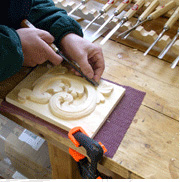
There are dozens of woodworking schools where you can go to learn furniture making, turning and even carving, so it is quite refreshing to find one that stands out from that crowd. The North House Folk School, tucked away on the shores of Lake Superior in tiny Grand Marais, Minnesota, does just that with a unique approach that can be summed up in one word: folkehojskole.
“The type of learning that is emphasized here is inspired by the Scandinavian folkehojskole,” explained Scott Pollock, the school’s Program Director, “where learning is valued for its own sake. Though students sign up for a project, they walk away with an experience far greater than any product can offer. It is about meeting other people and exploring and sharing stories. Of course, a lot of the classes we offer are eminently practical, but this is not a trade school. Our intention is to enrich lives and build community.
“The school was founded 10 years ago by a number of people, including Mark Hansen, a boat builder by hobby and social service worker by vocation. When he was in his 30s, he took a trip to Norway and visited some folk schools in isolated areas. Those schools focussed on boat building, but what fascinated him most was that people of all skill levels were able to feel successful at craft. 
“With that goal in mind, once back home, he started offering a three-week class on Inuit kayak building and was delighted to find that it drew people ranging in age from 13 to 62. That made him realize his course was bringing diverse people together for a long period; eating together, communicating and sharing. He wanted to do the same thing with other courses, and realized that beyond the benefits to the students, it would also be a boon to the town. Grand Marais, Minnesota is a small city located on the edge of a wilderness area adjacent to Lake Superior, and has only 500 inhabitants. Thanks to its locale, it was already a tourist destination.
“Mark got together with a number of other local crafts people including timber framers and boat builders, and put together a course catalog,” Scott recounted. “They talked the city of Grand Marais into leasing them an unused waterfront property with a number of old timber garages, which they converted to classrooms. One reason the city was so quick to support the school is because it is an educational nonprofit.
“The campus is small: only 250 feet by 250 feet, but it is packed with three major buildings and a blacksmith shop. We have no housing or food on campus, but because of our location, everything students need is within walking distance. Fortunately, the campus is situated next to a public campground, so people can come for a course and stay close by.
“Our tradition is teaching Northern crafts: everything from North American Inuit and Ojibwe to Scandinavian and Northern European. In short, anything from the northern hemisphere. We define North House as an educational organization that focuses on that northern tradition.
“There’s a good reason behind that. A lot of craft has traditionally been based on what materials have been at hand. Thus, regional craft work is related to what species were available, both in wood and fiber, as well as to the culture of the people who settled the area. The flat-bottom skiff, for example, a boat common in North America, has ties to the Norwegian pram. That shows both a cultural history and material practicality. Birch skis, which are endemic to Minnesota and are taught here, have their roots in Finland.
“We teach 1,300 students per year from all over North America in 250 different courses spread out over 17 disciplines. Courses range from outdoor skills, like sailing, homesteading and use of solar power, to food, music and fiber arts. Our wood-related courses cover timber framing, boat building, tool making, wood carving, woodworking and traditional crafts, a catchall for those skills that don’t fit into any other specific pigeonhole.
“The most popular arena is outdoor skills, but woodcarving is a close second. We cover the Scandinavian tradition of green wood carving, including making spoons, ale hand bowls, dragon and acanthus leaf carving, and flat plane people carving.
“Bowl and spoon carving starts with a fresh green log, often birch. The logs are halved and gouged out with an axe, a knife and a hook tool. The Norwegian ale bowl, another offered course, is turned on a foot-powered lathe, but instead of conventional lathe tools, cutting is done with a hook tool. The Scandinavian bowl tradition eschews the lathe, and instead uses an adze to hand hew the bowl while it is held on a carving bench. Spoons, too, start with an axe to split out the log, but most everything else is cut with a gouge and a knife.
“Our Viking Dragon Relief Carving class teaches a style often seen in Norway’s wooden Stave churches from the 13th century. Woven through the carvings are pre-Christian images, like dragons. Flat Plane Figure Carving is a folk art style that creates tiny figures about four inches tall made of wood scraps. It is all done with one knife, usually homemade, similar in size to a chip carving knife, though slightly different.
“One of the most unusual and interesting woodworking skills we teach is shpahn fahgle, which means ‘shaving bird.’ Though it is hard to believe, this delicate bird, with its wide fan of many feathers, is all carved from one piece of wood with one knife. The feathers are not separated, but all cut from a single block of green wood and fanned out without ever being detached from the piece of wood. It is believed that this carving technique originally comes from Russia and Finland. Our course is taught by Del Stubbs, a man more famous perhaps for turning. He picked up the skill during his travels throughout various folk schools in Scandinavia.
“When it comes to woodworking, we teach practical skills. Course listings include classes on making furniture, workbenches and a spring pole lathe. There’s even a course called Bury Yourself in Your Work, where students make a coffin.
“As part of the educational offering, we recently put out our first book, called Celebrating Birch, The Lore, Art and Craft of an Ancient Tree. There are 20 objects to create, including a basket, a carved box and step-by-step instructions on carving a wooden spoon. The book also delves into the history and origins of the school itself and some of the areas it teaches. In addition, it talks about birch craft, from the biology and ecology of the tree down to its usage.”
Speaking with Scott, the one thing that came through most clearly was his belief that these are skills anyone can learn. The school clearly emphasizes enjoyment and accessibility to the various crafts rather than an elite adoration of the end product. Scott summed it up nicely by sharing a sentiment from a fellow faculty member. “One of our teachers is fond of saying ‘Anything worth doing is worth doing poorly.’ What he means by that,” Scott explained, “is that craft is for everyone. When it comes right down to it, all of us started learning at the bottom.”
